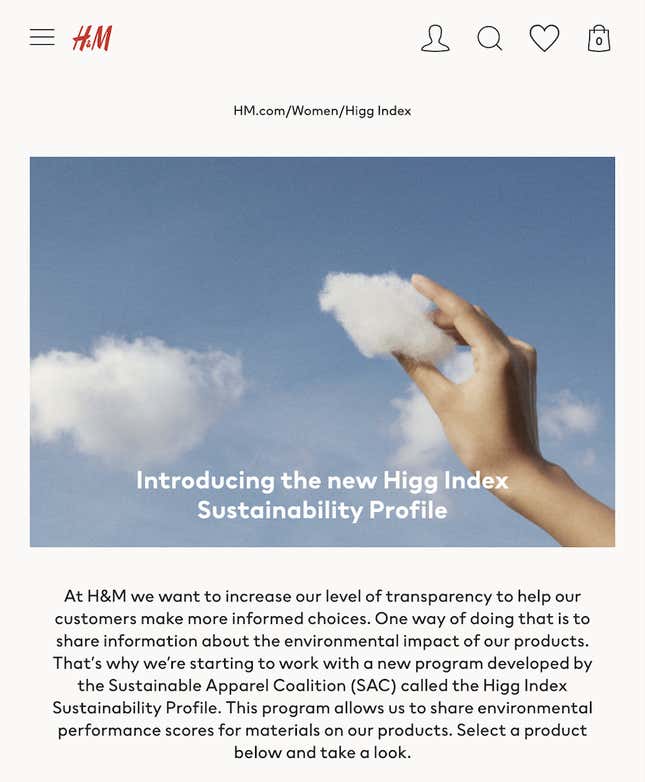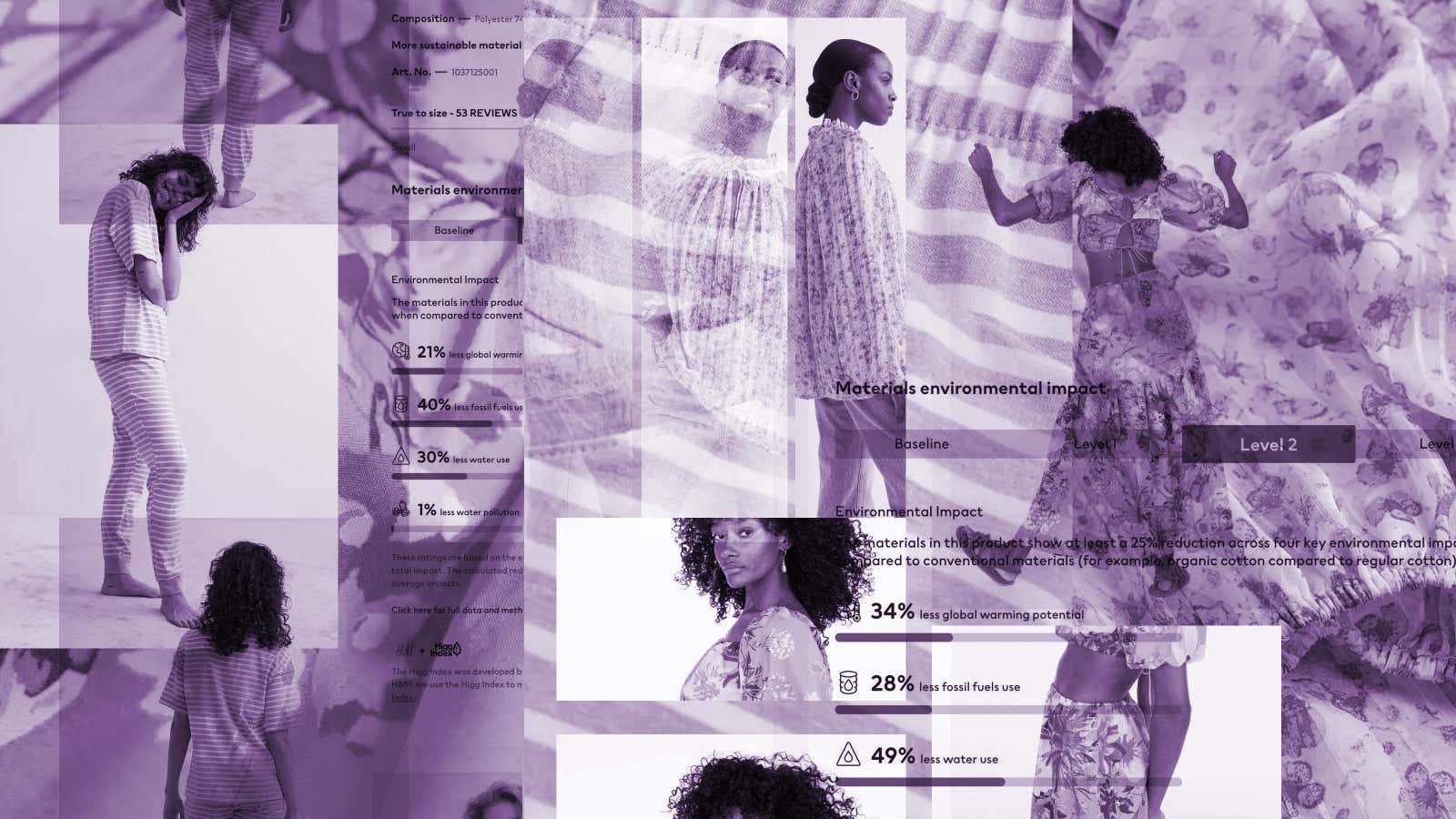Fast-fashion giant H&M showed customers environmental scorecards for its clothing that were misleading and, in many cases, outright deceptive, a Quartz investigation has found.
More than half of the scorecards on H&M’s website claimed that a piece of clothing was better for the environment when, in fact, it was no more sustainable than comparable garments made by the company and its competitors. In the most egregious cases, H&M showed data that were the exact opposite of reality.
The findings add to mounting skepticism and new regulatory scrutiny of the fast-fashion industry’s attempt to self-police its environmental record. H&M, the world’s second largest clothing company by sales volume, produces an estimated 3 billion garments per year, much of which goes unsold or is quickly discarded. It has tried to reform its image as a polluter by committing to new emissions goals and touting clothes labeled as a “Conscious Choice,” which were among those displaying the inaccurate data.
H&M removed all the environmental scorecards from its website soon after Quartz told the company about our findings on Monday. Shortly thereafter, a trade group formed by H&M and other major apparel companies said it would “pause” making the scorecard data public while it conducted a review of its methodology. The group said it was responding to a notification from the Norwegian Consumer Authority that questioned sustainability claims made by H&M and other apparel firms that relied on the same data as the scorecards.
The rapid retreat by H&M and its industry peers adds to the argument that there is no such thing as sustainable fast fashion. Even the data now in question, an industry-developed metric known as the Higg Index, merely grades the impact of producing an article of clothing compared to the status quo. It has been widely adopted by apparel makers but brutally criticized by environmental groups.
H&M, based in Stockholm, didn’t respond to our detailed questions about how its environmental scorecards went so awry. In a statement, the company said, “We came across a couple of technical issues that we are looking into,” but didn’t elaborate. It defended the goals of the Higg Index: “We want to be able to share understandable sustainability performance data on a product level and we want this data to be industry standardized.”
Tipping the scorecards in H&M’s favor
The scorecards in question are called Higg Sustainabililty Profiles. They were created by the industry group, known as the Sustainable Apparel Coalition (SAC), to give customers a way to compare the environmental impact of their purchases. The profiles incorporate factors like how much water and fossil fuels were used to create the materials in a piece of clothing, compared to conventional fabrics.
But in many cases, H&M displayed data that gave a totally wrong picture of a garment’s impact on the environment. Those errors came about because the retailer’s website ignored negative signs in Higg Index scores. For instance, a dress with a water-use score of -20%—as in, it uses 20% more water than average—was listed on H&M’s website as using 20% less.
Hard-coding positive language
In fact, words like “less” and “reduction” were written, or hard-coded, into H&M’s website such that its environmental scorecards could only offer a green picture of its clothing, our investigation found.
Of the 600 women’s clothing scorecards on H&M’s UK site last week, more than 100 of them included errors that made less sustainable clothing appear to be the opposite. The scorecards were in use on H&M’s US and European websites since May 2021, but we couldn’t determine if the errors were there all along.
Like all retail websites, H&M’s contains placeholder text in its code to accompany data about a particular product that’s usually fetched from a database. On product pages that included information about the Higg Index, the placeholders assumed only the best. This is what some of the code looked like:
breakdownLabels: { waterUse: 'less water use', co2: 'less global warming potential', chemicals: 'Chemicals', waterPollution: 'less water pollution', fossil: 'less fossil fuels use' },
Another bit of placeholder text, now deleted, read "{0} less than conventional materials." The value in braces would change based on the particular data. But there was no alternative text for the many products with more impact than conventional materials.
Scorecards for unremarkable products
The vast majority of items on H&M’s website have never included a scorecard. Those garments that did were surrounded by text about their environmental record and included on a special page featuring a women’s hand reaching into the clouds.

One might assume these garments were better for the environment than typical, but simply having a Higg Index rating does not mean a garment is more sustainable. Over half of the garments with scorecards in our analysis showed no improvement from the Higg Index’s baseline, making them hardly different than the 9,600 other women’s clothing items found on H&M’s UK site.
On the days Quartz logged the data, over 600 items of women’s clothing were listed as having Higg Sustainabililty Profiles. Most showed no improvement whatsoever.
In its statement, H&M argued that displaying a scorecard didn’t imply anything other than a commitment to environmental transparency: “We share information on individual products no matter if the score is good or bad. We do this because we believe that transparency is key to driving sustainable change across the industry, as it creates both comparability and accountability, and this will ultimately lead to positive change.”
Crackdown on greenwashing
The Higg Index has faced criticism ever since H&M and other clothing retailers launched the effort, but now regulatory scrutiny may force the companies to take a new approach. Norway’s consumer protection agency earlier this month sent a notice to H&M that called out the index: “For H&M to avoid misleading marketing, H&M should specifically assess/reassess the justification for using the Higg MSI as a communicative tool in marketing,” the agency wrote.
SAC, the industry group, announced on Monday that it was suspending use of the Higg Index in all consumer-facing contexts and initiating an independent review of the data and how it’s compiled.
“The Higg Index Customer Facing Transparency Program has temporarily been paused by the SAC and following this decision, we decided to take down the program in all markets’ online shops where it has currently been available,” H&M said in its statement to Quartz. “This is a gradual process that takes some days and we started with the UK.”
Over the past two days, Quartz observed references to the Higg Index disappearing from H&M’s websites in the US and UK.
George Harding-Rolls, a campaign manager at the Changing Markets Foundation and a critic of the Higg Index, said the initiative was designed to mislead people.
“The SAC has been providing green paint to paint a very very dirty industry an eco-shade for 10 years, and haven’t really shown any measurable results in that time,” he said in an interview. “Take those H&M false claims: how many of those products have been bought, or were more likely to have been bought, by somebody?”
